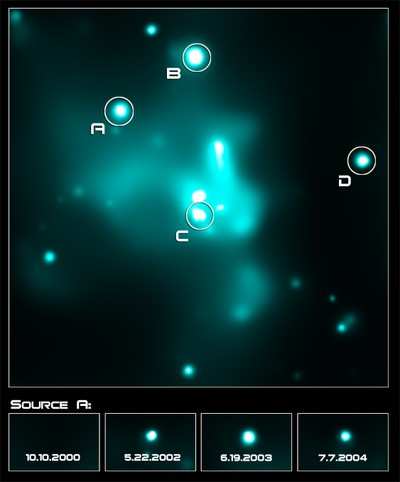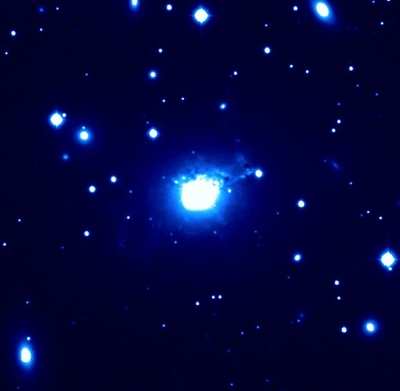Reports Hundreds Of New Anomalies Unmasked
NASA tells ANN astronomers have unmasked hundreds of black holes
hiding deep inside dusty galaxies billions of light-years away.

The massive, growing black holes, discovered by NASA's Spitzer
and Chandra space telescopes, represent a large fraction of a
long-sought missing population. Their discovery implies there were
hundreds of millions of additional black holes growing in our young
universe, more than doubling the total amount known at that
distance.
"Active, supermassive black holes were everywhere in the early
universe," said Mark Dickinson of the National Optical Astronomy
Observatory in Tucson, AZ. "We had seen the tip of the iceberg
before in our search for these objects. Now, we can see the iceberg
itself."
Dickinson is a co-author of two new papers appearing in the
November 10 issue of the Astrophysical Journal. Emanuele Daddi of
the Commissariat a l'Energie Atomique in France led the
research.
The findings are also the first direct evidence that most, if
not all, massive galaxies in the distant universe spent their
youths building monstrous black holes at their cores.
 For decades, a large
population of active black holes has been considered missing. These
highly energetic structures belong to a class of black holes called
quasars. A quasar consists of a doughnut-shaped cloud of gas and
dust that surrounds and feeds a budding supermassive black hole. As
the gas and dust are devoured by the black hole, they heat up and
shoot out X-rays. Those X-rays can be detected as a general glow in
space, but often the quasars themselves can't be seen directly
because dust and gas blocks them from our view.
For decades, a large
population of active black holes has been considered missing. These
highly energetic structures belong to a class of black holes called
quasars. A quasar consists of a doughnut-shaped cloud of gas and
dust that surrounds and feeds a budding supermassive black hole. As
the gas and dust are devoured by the black hole, they heat up and
shoot out X-rays. Those X-rays can be detected as a general glow in
space, but often the quasars themselves can't be seen directly
because dust and gas blocks them from our view.
"We knew from other studies from about 30 years ago that there
must be more quasars in the universe, but we didn't know where to
find them until now," said Daddi.
Daddi and his team initially set out to study 1,000 dusty,
massive galaxies that are busy making stars and were thought to
lack quasars. The galaxies are about the same mass as our own
spiral Milky Way galaxy, but irregular in shape. At 9 to 11 billion
light-years away, they existed at a time when the universe was in
its adolescence, between 2.5 and 4.5 billion years old.
When the astronomers peered more closely at the galaxies with
Spitzer's infrared eyes, they noticed that about 200 of the
galaxies gave off an unusual amount of infrared light. X-ray data
from Chandra, and a technique called "stacking," revealed the
galaxies were, in fact, hiding plump quasars inside. The scientists
now think that the quasars heat the dust in their surrounding
doughnut clouds, releasing the excess infrared light.
"We found most of the population of hidden quasars in the early
universe," said Daddi. Previously, only the rarest and most
energetic of these hidden black holes had been seen at this early
epoch.
The newfound quasars are helping answer fundamental questions
about how massive galaxies evolve. For instance, astronomers have
learned that most massive galaxies steadily build up their stars
and black holes simultaneously until they get too big and their
black holes suppress star formation.
The observations also suggest that collisions between galaxies
might not play as large a role in galaxy evolution as previously
believed. "Theorists thought that mergers between galaxies were
required to initiate this quasar activity, but we now see that
quasars can be active in unharassed galaxies," said co-author David
Alexander of Durham University, United Kingdom.

"It's as if we were blindfolded studying the elephant before,
and we weren't sure what kind of animal we had," added co-author
David Elbaz of the Commissariat a l'Energie Atomique. "Now, we can
see the elephant for the first time."
The new observations were made as part of the Great
Observatories Origins Deep Survey, the most sensitive survey to
date of the distant universe at multiple wavelengths.
Consistent results were recently obtained by Fabrizio Fiore of
the Osservatorio Astronomico di Roma, Italy, and his team. Their
results will appear in the Jan. 1, 2008, issue of Astrophysical
Journal.
 SpaceX to Launch Inversion RAY Reentry Vehicle in Fall
SpaceX to Launch Inversion RAY Reentry Vehicle in Fall Aero-News: Quote of the Day (04.23.24)
Aero-News: Quote of the Day (04.23.24) Aero-News: Quote of the Day (04.20.24)
Aero-News: Quote of the Day (04.20.24) ANN's Daily Aero-Linx (04.20.24)
ANN's Daily Aero-Linx (04.20.24) Aero-News: Quote of the Day (04.21.24)
Aero-News: Quote of the Day (04.21.24)





